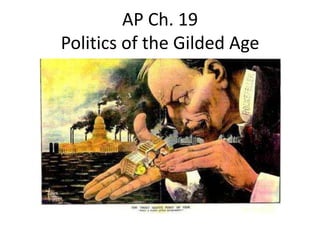
AP Ch. 19: Politics and Presidents of the Gilded Age
- 1. AP Ch. 19 Politics of the Gilded Age
- 2. Characteristics • National government had very little effect on citizens during the Gilded age—not proactive. • Electoral Stability: almost same number of states controlled by each party—South— Democrat and North-Republican. • Voter turn out high—less because of interest in national issues than because interest in regional, ethnic and cultural sentiments.
- 3. Hayes®, Garfield, Arthur, Cleveland, Ha rrison and Cleveland
- 4. Party Loyalties • Republicans •Democrats •Support: • Support: Farmers from Bankers, BB, industrialists, the G.P., immigrants, very farmers from the strong in the South Midwest •Catholics •Protestants •Not interested in •“Party of Morality” legislating morality •Favored temperance •Against high tariffs •Supported immigration restrictions •Favored Tariffs
- 5. • The United States in the Gilded Age was a country without a modern, federal state. The most powerful national political institutions were the 2 political parties and the Federal courts. The political parties were controlled by political bosses and machines. • Democrats –big city organizations • Republicans-state organizations
- 6. Presidents and Patronage • Presidents made a huge number of appointments to fulfill their obligations to the political machine that got you elected. • Sometimes over 100,000—President Hayes found it nearly almost impossible—by the end of his term, his own party was spliting • Stalwarts and the Half-Breeds
- 7. • On the surface the Stalwarts favored traditional, professional machines while the Half-Breeds favored reform, but in reality neither wanted true reform.
- 8. 19th Hayes • Republican • Compromise of 1877 • Worked on Civil Service Reform
- 9. 20th Garfield • Republican 1881- 4 months • Halfbreed • Took on Roscoe Conkling—made appointments based on merit— Assassinated by a Stalwart
- 10. 21st Arthur • Republican 1881-1885 • Friend of Conkling, yet followed an independent path—promoted reform by supporting civil service reform—Pendleton Act • Chinese Exclusion Act 1882
- 11. 22nd Cleveland • Democrat 1885-1889 • “though the people support the Government, the Government should not support the people” • Dawes Act • Against high tariffs
- 12. 23rd Harrison • Republican 1889-1893 • During his administration, public opinion started to change—reform the corporations • Sherman Anti-trust Act—a weak, unenforced bill to help curb public criticism on monopolies • Sherman Silver Purchase Act-gov. buy 4.5 m. oz. of silver each month • The McKinley tariff –high protective-48%
- 13. 24th Cleveland • Democrat 1893-1897 • Second term devoted to minimal gov. • Interstate Commerce Act—rail rates must be “reasonable and just” • Repeal of the Sherman Silver Act—fight between the conservatives favoring gold(making $ tight) and Populists who wanted free coinage of silver(inceasing $ supply) creating a split in the Demo. Party— • Goldbugs and silverites
- 14. • The American people were starting to rubble and become frustrated over concerns such as the tariff, the trusts and monopolies and the unfair practices of the railroads and the Federal government was doing nothing. • Change was coming and it would upset the political equilibrium of the Gilded Age